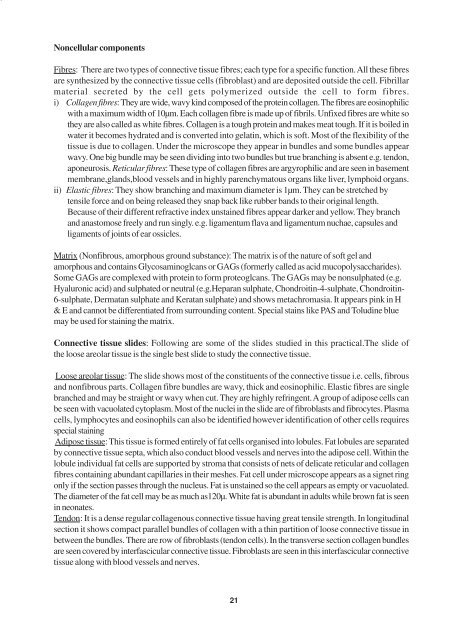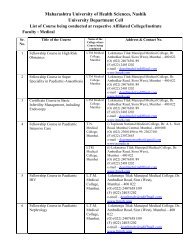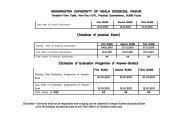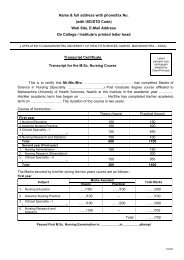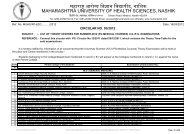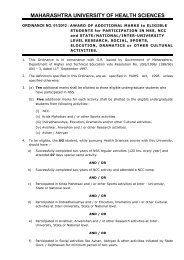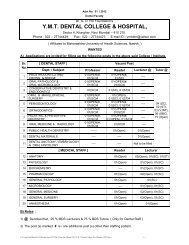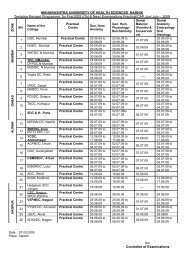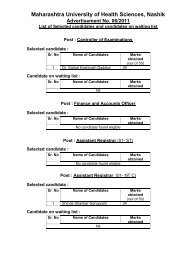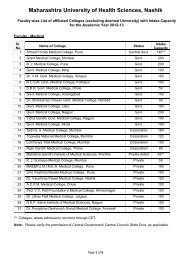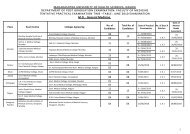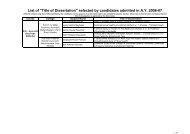Unit I
Unit I
Unit I
Create successful ePaper yourself
Turn your PDF publications into a flip-book with our unique Google optimized e-Paper software.
Noncellular componentsFibres: There are two types of connective tissue fibres; each type for a specific function. All these fibresare synthesized by the connective tissue cells (fibroblast) and are deposited outside the cell. Fibrillarmaterial secreted by the cell gets polymerized outside the cell to form fibres.i) Collagen fibres: They are wide, wavy kind composed of the protein collagen. The fibres are eosinophilicwith a maximum width of 10µm. Each collagen fibre is made up of fibrils. Unfixed fibres are white sothey are also called as white fibres. Collagen is a tough protein and makes meat tough. If it is boiled inwater it becomes hydrated and is converted into gelatin, which is soft. Most of the flexibility of thetissue is due to collagen. Under the microscope they appear in bundles and some bundles appearwavy. One big bundle may be seen dividing into two bundles but true branching is absent e.g. tendon,aponeurosis. Reticular fibres: These type of collagen fibres are argyrophilic and are seen in basementmembrane,glands,blood vessels and in highly parenchymatous organs like liver, lymphoid organs.ii) Elastic fibres: They show branching and maximum diameter is 1µm. They can be stretched bytensile force and on being released they snap back like rubber bands to their original length.Because of their different refractive index unstained fibres appear darker and yellow. They branchand anastomose freely and run singly. e.g. ligamentum flava and ligamentum nuchae, capsules andligaments of joints of ear ossicles.Matrix (Nonfibrous, amorphous ground substance): The matrix is of the nature of soft gel andamorphous and contains Glycosaminoglcans or GAGs (formerly called as acid mucopolysaccharides).Some GAGs are complexed with protein to form proteoglcans. The GAGs may be nonsulphated (e.g.Hyaluronic acid) and sulphated or neutral (e.g.Heparan sulphate, Chondroitin-4-sulphate, Chondroitin-6-sulphate, Dermatan sulphate and Keratan sulphate) and shows metachromasia. It appears pink in H& E and cannot be differentiated from surrounding content. Special stains like PAS and Toludine bluemay be used for staining the matrix.Connective tissue slides: Following are some of the slides studied in this practical.The slide ofthe loose areolar tissue is the single best slide to study the connective tissue.Loose areolar tissue: The slide shows most of the constituents of the connective tissue i.e. cells, fibrousand nonfibrous parts. Collagen fibre bundles are wavy, thick and eosinophilic. Elastic fibres are singlebranched and may be straight or wavy when cut. They are highly refringent. A group of adipose cells canbe seen with vacuolated cytoplasm. Most of the nuclei in the slide are of fibroblasts and fibrocytes. Plasmacells, lymphocytes and eosinophils can also be identified however identification of other cells requiresspecial stainingAdipose tissue: This tissue is formed entirely of fat cells organised into lobules. Fat lobules are separatedby connective tissue septa, which also conduct blood vessels and nerves into the adipose cell. Within thelobule individual fat cells are supported by stroma that consists of nets of delicate reticular and collagenfibres containing abundant capillaries in their meshes. Fat cell under microscope appears as a signet ringonly if the section passes through the nucleus. Fat is unstained so the cell appears as empty or vacuolated.The diameter of the fat cell may be as much as120µ. White fat is abundant in adults while brown fat is seenin neonates.Tendon: It is a dense regular collagenous connective tissue having great tensile strength. In longitudinalsection it shows compact parallel bundles of collagen with a thin partition of loose connective tissue inbetween the bundles. There are row of fibroblasts (tendon cells). In the transverse section collagen bundlesare seen covered by interfascicular connective tissue. Fibroblasts are seen in this interfascicular connectivetissue along with blood vessels and nerves.21


